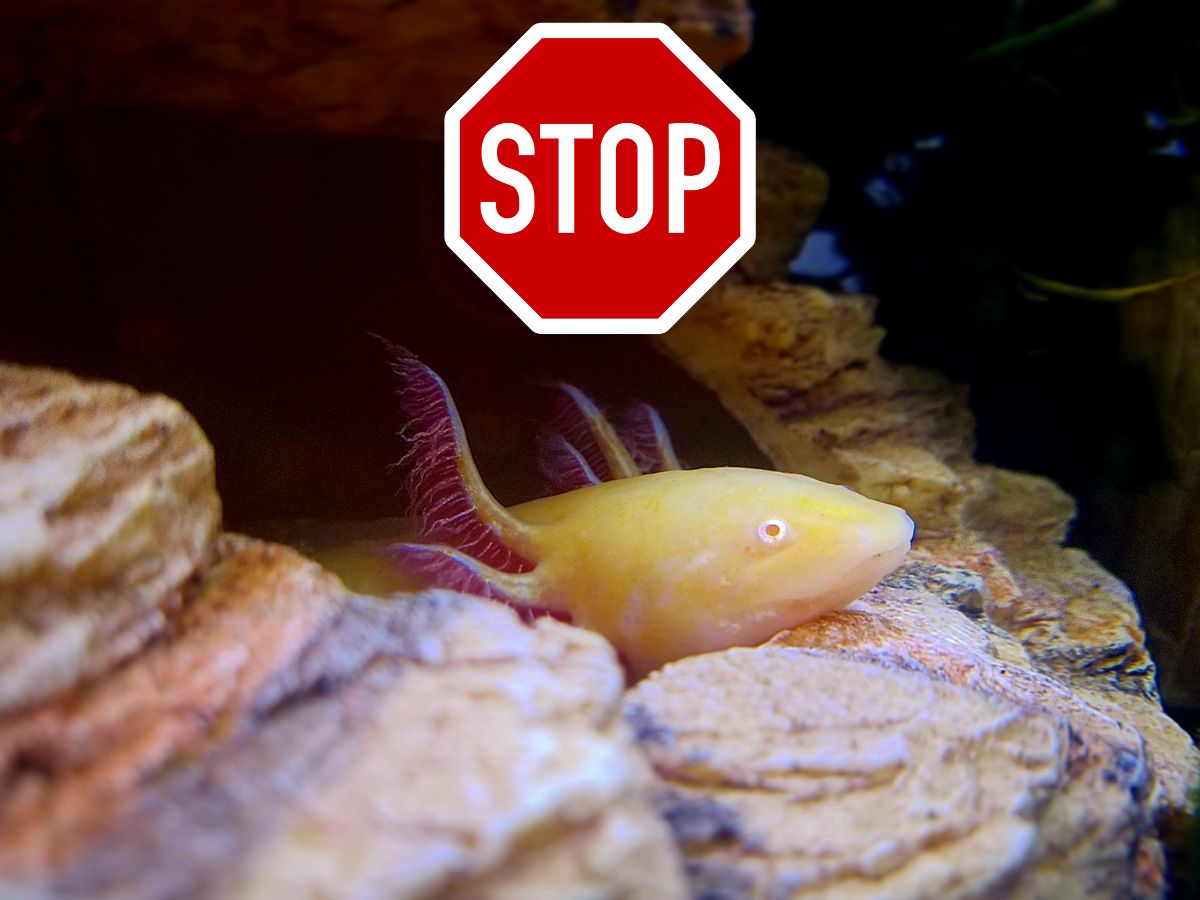Axolotls are animals that are rather straightforward in their care, yet there are always some mistakes that are made by beginners. In this article you will learn how to avoid such mistakes.
1. Too high temperatures
One of the most common mistakes in keeping Axolotls is a too high water temperature.
Axolotls are cold-water animals that usually live in water temperatures between 53 and 68°F (12 and 20°C) in their native home in Lake Xochimilco. Thus they can handle low temperatures well, even short-term temperatures between 41 and 50°F (5 and 10°C) don’t bother them. But from a water temperature above 71°F (22°C) it becomes clearly too warm for them.
Too high water temperatures cause heat stress in axolotls and they become more susceptible to diseases and infections.
2. Bad tank mates
Axolotls are not animals that are easily kept with other species, the safest companionship for them is with another axolotl of the same size.
The dangers of the wrong tank mate are often fatal to both the axolotl and the other animals.
The axolotl sees everything that swims in front of its mouth as food and will try to eat it. This is why catfish should never be kept with an axolotl, as they have a stinger that they can raise in danger, seriously injuring the axolotl if it tries to eat them. Also, catfish like to rasp at surfaces which can leave deep wounds on the axolotl’s skin.
Also, the water conditions can be so different that both species cannot live happily in the tank.
Animals that should not be kept together with an Axolotl are e.g. tropical fish that need a too high water temperature, as well as crayfish, sticklebacks and clawed frogs, because they are very likely to hurt the Axolotl.
Another danger from tank mates are germs and parasites that other animals can bring into the aquarium. Here is an article about all the animals you should never keep together with an Axolotl.
In general it can be said that you can only keep an Axolotl together with a few species together and you should inform yourself well if the animals get along with each other, here you can find an article about animals where the chances are good that it will work.
3. A strong current
The Axolotl’s natural environment, Lake Xochimilco is a low current, almost stagnant body of water, therefore Axolotls are usually very sensitive to too strong currents from filters and pumps. Strong currents can cause the axolotl to become stressed and stop eating. Recognizing if your Axolotl is stressed or not is not always easy, so here is an article about the different signs to be aware of.
Young axolotls that are not yet fully grown are much more sensitive to strong currents, but it is also not good for adult axolotls. Therefore the current should be hardly noticeable at the bottom of the tank and also kept as low as possible in the rest of the aquarium.
4. The wrong substrate
Axolotls catch their food by sucking the prey into their mouth. It can happen that loose substrate, if it consists of stones, gravel or sand, ends up in their digestive tract. The Axolotl often spits out some of the gravel or they are excreted, but with larger or sharp stones it can come to blockages or internal injuries. Especially constipation can be fatal for an axolotl.
Therefore, you should be careful to choose a substrate that will not injure the axolotl if it swallows it. Sand or round gravel with a grain size below 3/32 inches (3mm) diameter is a good choice.
You should never keep Axolotl with plastic or plastic coated gravel, because the coating can dissolve in the stomach acid of the Axolotl.
You can also keep your Axolotl without substrate, just on the glass bottom of the aquarium, in which case there is no risk of it swallowing pebbles and becoming constipated. However, it can be stressful for some axolotls, as they find less grip on the glass. In this case, you can lay out plastic plates on the floor so the axolotl can move around better.
Here is an article comparing the different substrate options for axolotls.
You should also be careful when decorating the tank, wooden roots can quickly become a source of germs that can settle on them and make the axolotl sick. Wood in the aquarium does not necessarily lead to problems, but especially beginners should rather avoid it for the time being.
5. Use of water conditioners or fertilizers
The water conditioners from fish tanks and fertilizers for aquatic plants should not be used with an axolotl, they often contain chemicals that axolotls do not tolerate and make them sick, so it is safer to avoid them altogether.
6. Wrong Food
Another common problem with keeping axolotls is overfeeding, when axolotls are fed too much or too often.
Axolotl digestion tends to be slow and they need breaks in between feedings to properly digest food. Mature, adult animals generally need less food than growing ones. However, axolotls are always on the lookout for food and will often eat food offered to them, even if they are no longer hungry, which can quickly lead to overfeeding.
An adult axolotl only needs to be fed every two to three days. Overfeeding can lead to digestive problems and in the worst case, constipation.
Another point that should be mentioned about feeding is that you should not touch your Axolotl unnecessarily and only use clean, washed hands in the tank, otherwise you can introduce germs and bacteria.
Conclusion
If you pay attention to these things, you have already avoided the most common mistakes of axolotl owners and saved your axolotl a lot of stress. Particularly, too high water temperatures are very harmful to the health of axolotls, so you should keep an eye on the temperatures, especially in the summer.

